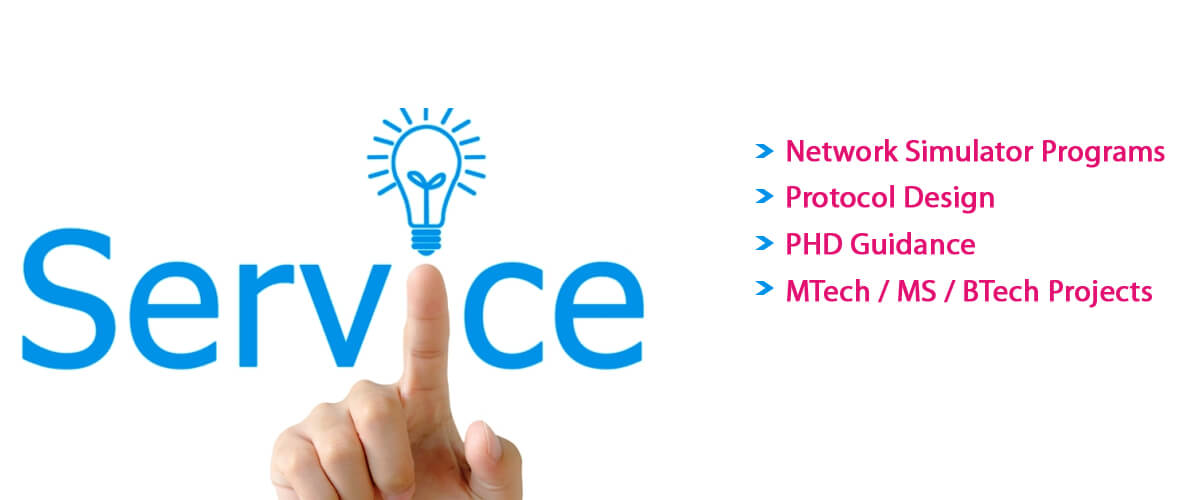Network Communication Research Topics in Information Technology
Network Communication Research Topics in Information Technology that are hard to get it done from scholar’s end are easily handled by us. Every day we stay awake on latest updates on IT filed and have all the research methodologies to get your work done on time. IT (Information Technology) is the most demanding field among scholars, as it is often upgraded with effective algorithms and many career paths are introduced through this platform. Incorporating the NS2 for simulations, we provide numerous research topics with brief explanations:
- Performance Comparison of Routing Protocols in MANETs
- Considering the diverse network densities and mobility patterns, examine the specific functionalities of various MANET (Mobile Ad-hoc Network) routing protocols. This project focuses on metrics like network throughput, end-to-end delay and packet delivery ratio.
- Evaluating QoS in VoIP over Different Network Technologies
- Across diverse network mechanisms such as WiFi, 3G and 4G, QoS (Quality of Service) parameters are supposed to be contrasted for VoIP (Voice over IP). Metrics such as packet loss, response time and jitter are highly focused in this research.
- Comparison of TCP and UDP Performance in IoT Environments
- Simulate the IoT (Internet of Things) contexts with the application of NS2. On the subject of energy usage, data throughput and integrity, the role of TCP (Transmission Control Protocol) against UDP (User Datagram Protocol) must be contrasted.
- Energy Efficiency of Wireless Sensor Networks (WSNs)
- In preserving adequate hierarchy of functionalities, examine the various energy-saving routing protocols and define which are more powerful among others in enhancing the durability of the network through contrasting it for WSNs.
- Impact of SDN on Network Performance and Security
- Under various metrics such as safety, functionality and adaptability, it is advisable to assess the variations among SDN (Software-Defined Networking) platforms and conventional networking configuration by simulating them.
- VANET Protocol Efficiency in Urban vs. Rural Settings
- As regards vehicle density implications, integrity and response time, the potential strength of different VANET (Vehicular Ad-hoc Network) protocols have to be contrasted based on various platforms (urban vs. rural).
- Effectiveness of Congestion Control Mechanisms in High-Speed Networks
- This project mainly concentrates on metrics like response time, authenticity and throughput. In high-speed network platforms, diverse traffic control algorithms such as BBR, TCP Vegas and TCP Reno are meant to be evaluated and contrasted.
- LTE vs. WiMAX: A Comparative Simulation Study in NS2
- With regard to user efficiency, bandwidth efficacy and coverage area, a comparative analysis on WiMAX and LTE mechanisms should be carried out in an effective manner.
- Multicast Routing in Large-Scale Networks
- Regarding the determinants such as network topology modification, source distribution and societal forces, the functionality of multicast routing protocols in extensive networks are meant to be contrasted.
- Simulation of Cyber-Attack Impacts on Network Performance
- In order to assess the efficiency of various reduction tactics, functionality of the network with regard to diverse cyber-assault events such as worm threats and DDoS assaults need to be designed and contrasted.
- 5G Network Performance in Dense Urban Environments
- Including past generations such as 4G in highly populated urban platforms, the simulated functionality of 5G networks ought to be contrasted. It emphasizes metrics like capability, throughput and response time.
- NS2-Based Comparison of IPv4 and IPv6 in Enterprise Networks
- Aiming at safety, address management and adaptability, we have to assess the functionality variations among IPv6 and IPv4 protocols in an organizational network platform.
How to finalize Engineering subjects for Information Technology Research?
Finalizing the topics of your research is really a challenging process, but with our proper guidance, you can accomplish it smoothly. Based on Information Technology study, a systematic guide is proposed by us for assisting you in confirming the Engineering subjects:
- Detect Existing Patterns and Requirements
- Literature Review: In accordance with the domain of networking and cybersecurity, an extensive analysis should be carried out on latest documents, articles and term papers. For interpreting existing problems, methodologies and research patterns, this approach guides us effectively.
- Industry Documents and News: From technology analysis firms, IT industry and cybersecurity enterprises, we must delve into trade-related documents. As regards evolving attacks and critical problems, meaningful perspectives are offered by means of cybersecurity records and technology news environments.
- Evaluate the Significance and Implications
- Industry Significance: Regarding the realistic events, the real-time implications of possible research topics are required to be assessed. Examine our study; in what manner it discusses the requirements of certain industries like modeling high-effective network management tactics or enhancing the network security protocols.
- Societal Implications: On community, inquire about the overall effects of our study. It could be development of security to maintain secrecy in enterprise or personal interaction or optimization of cybersecurity standards for public architecture.
- Gap Analysis
- Research Gaps: Especially in the current literature, detect the gaps crucially where it requires further exploration or unsolved questions. It is important to seek areas in which it has incompatible results in the existing study or underexplored regions.
- Technological Gaps: Among the areas of networking and cybersecurity, we need to look for technical problems, where present findings are insufficient or there is still a lack of addressing some issues. It might involve areas such as enhancing the network functionality for 5G and across networks or development of protection in evolving IoT networks.
- Discuss with Professionals
- Academic Supervisors: Seek the guidance of academic professionals who are skilled in networking and cybersecurity to address our main concepts and results. According to the practicality and significance of our research topics, they can offer beneficial insights.
- Industry Experts: We have to collaborate with academic supervisors who are dealing with cybersecurity, IoT and networking. General problems which are addressed by the firms are solved by them with their applicable knowledge. To develop critical effects through our study, they also recommend possible areas.
- Assess Resources and Practicality
- Accessibility of Resources: For providing further assistance to our study, make sure of resources like software tools and datasets, whether we have the approval for implementation. For example, network simulators such as NS2 can be preferred for networking studies.
- Expertise and Experience Curve: Our present expertise needs to be evaluated. As reflecting on novel methodologies or tools which we aim to deploy, investigate the needed training phase. Depending on the techniques required which we obtained practically or our potential capacity, it is crucial to select a compelling subject.
- Develop Research Questions
- Model SMART (Specific, Measurable, Achievable, Relevant and Time-bound) research questions on the basis of our results from the measures which are discussed previously. In the area of networking and cybersecurity, the main extent and goals of our study have to be supported by these questions.
- Experimental Research and Prototyping
- To examine the practicality of our research methodologies or questions, focus on creating prototypes or performing empirical research, ahead of confirming our research subject. This approach is very useful for assuring the practicality and optimizing the objective of our project.
- Revise and Optimize
- As we are intensely engaged in our study, our selected research subjects should be revised frequently. In terms of technological enhancements or reviews from the educational and expert groups or innovative results, don’t hesitate to convert or optimize our aims.
Considering the comparison of NS2 simulations, we offer efficient and capable research topics in the area of Information Technology. According to this area, some of the crucial measures are provided by us that must be pursued in the finalizing process of topics with respect to IT research.
Research Ideas in Information Technology
Look out for Research Ideas in Information Technology which our team have worked , read it out if you are in need of help we will provide you with best results.
- Privacy Preserving Data Mining Classifier for Smart City Applications
- Ontology Model for Multi-relational Data Mining Application
- Research on Intelligent Acceleration Algorithm for Big Data Mining in Communication Network Based on Support Vector Machine
- Fault Data Mining on the Encoders in Numeric Control System Based on the Information Redundancy of Velocity
- Study on the material requisition system based on data mining
- A Workflow Management System for Scalable Data Mining on Clouds
- Research on the Application of Data Mining Technology in Enterprise Supply Chain Management System
- Survey of Depression Detection using Social Networking Sites via Data Mining
- An open web services – based framework for data mining of biomedical image data
- An useful system based data mining of the ore mixing in sintering process
- A novel algorithm for distributed data mining in HDFS
- A new data mining based network Intrusion Detection model
- Variable reduction for multi-objective optimization using data mining techniques; application to aerospace structures
- Detecting security threats in the network core using Data Mining techniques
- Proposal of a Computer System for Vocational Guidance with Data Mining
- Research and application of data-mining technique in timetable scheduling
- A Personalized Resource Recommendation System Using Data Mining
- Improving Admission Control Policies in Database Management Systems, Using Data Mining Techniques
- Research of artificial neural networks usage in data mining and semantic integration
- Tracking Representational Flexibility Development through Speech Data Mining







